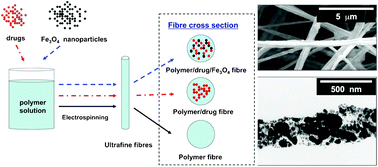Fabrication of magnetic drug-loaded polymeric composite nanofibres and their drug release characteristics†
Abstract
Magnetic

* Corresponding authors
a
Department of Biomedical Science, University of Sheffield, Firth Court, Western Bank, Sheffield, S10 2TN, UK
E-mail:
linge.wang@sheffield.ac.uk
Fax: +44 (0)114 222 2787
Tel: +44 (0)114 222 4662
b
Shenzhen Zhijun Pharmaceutical Co. Ltd, Shenzhen, China
E-mail:
wangmeng@gic.ac.cn
c
Chemical Engineering and Applied Chemistry, Aston University, Birmingham, B4 7ET, UK
E-mail:
p.d.topham@aston.ac.uk
Tel: +44 (0)121 204 3413
d
Natural Research Center for Engineering Plastics, Technical Institute of Physics & Chemistry, Chinese Academy of Sciences, Beijing, China,
E-mail:
yhunag@mail.ipc.ac.cn
Fax: +86 (0)10 62554670
Tel: +86 (0)10 82543478
e State Key Laboratory of Polymer Physics and Chemistry, Institute of Chemistry, Chinese Academy of Sciences, Beijing, China
Magnetic

 Please wait while we load your content...
Something went wrong. Try again?
Please wait while we load your content...
Something went wrong. Try again?
L. Wang, M. Wang, P. D. Topham and Y. Huang, RSC Adv., 2012, 2, 2433 DOI: 10.1039/C2RA00484D
To request permission to reproduce material from this article, please go to the Copyright Clearance Center request page.
If you are an author contributing to an RSC publication, you do not need to request permission provided correct acknowledgement is given.
If you are the author of this article, you do not need to request permission to reproduce figures and diagrams provided correct acknowledgement is given. If you want to reproduce the whole article in a third-party publication (excluding your thesis/dissertation for which permission is not required) please go to the Copyright Clearance Center request page.
Read more about how to correctly acknowledge RSC content.
 Fetching data from CrossRef.
Fetching data from CrossRef.
This may take some time to load.
Loading related content
